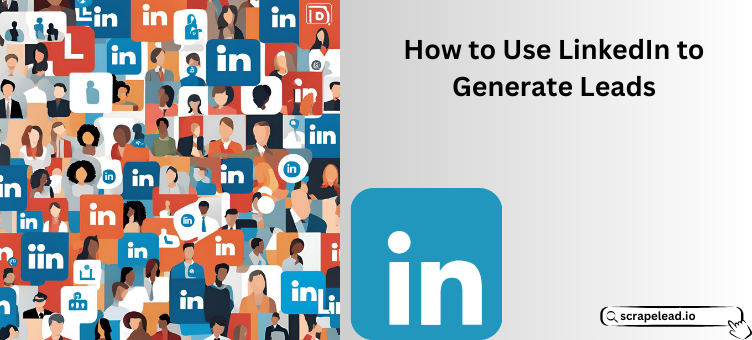
How to Use LinkedIn to Generate Leads
Many years ago, I thought I was doing everything right on LinkedIn for lead generation—sending connection requests, posting content, even occasionally commenting on a few posts. Guess what? Crickets. No replies, no leads, nothing.🙁
Then I realized… LinkedIn isn’t just a digital resume. It’s a powerful B2B sales LinkedIn machine. And if you’re not using it strategically, you’re leaving high-quality leads (and money) on the table.
So, I changed it all. I optimized my profile, started using LinkedIn lead gen ads, used LinkedIn Sales Navigator, and built a targeted network. And the leads started rolling in—without having to cold pitch strangers or sounding salesy.
So, here’s breaking it all down for you. In this guide, I will be sharing proven strategies to generate leads on LinkedIn from profile optimization, through LinkedIn tools for lead generation, and some automation hacks.
If you seriously want to know how to generate leads on LinkedIn, let’s get started.
(Note: We’ve gone ahead and hid all the LinkedIn names in the photos—because privacy matters, and we’re not in the business of revealing secrets!)
Follow these Strategies to Generate Leads on LinkedIn
1. Optimize Your LinkedIn Profile
Your LinkedIn profile is also important as your biodata🤣. Take it seriously.
Your LinkedIn profile is your first impression and never forget that “First impression is last impression.”
Think of it as your personal sales page.
Here are some tips to make it stand out and attract B2B leads LinkedIn:
1. Create a Winning First Impression with Your Photo & Banner
Use only professional photos in which your head is visible.
Don’t add a stylish photo with cringy poses. This is LinkedIn, not Instagram.
Add a customized banner that reflects your brand, skills, and expertise.

2. Make Your Headline Work for You
Add a catchy, clear, and engaging headline. Because your headline is prime real estate – so make it count!
For example:


3. Tell Your Story in the About Section
Directly speak to your audience in the About section.
Address their pain points, and explain how you can solve their problem. (Do some smart work dude!😎)
And in the end, don’t forget to add a clear call-to-action (CTA).
For example: Let’s connect, Visit my website, etc.
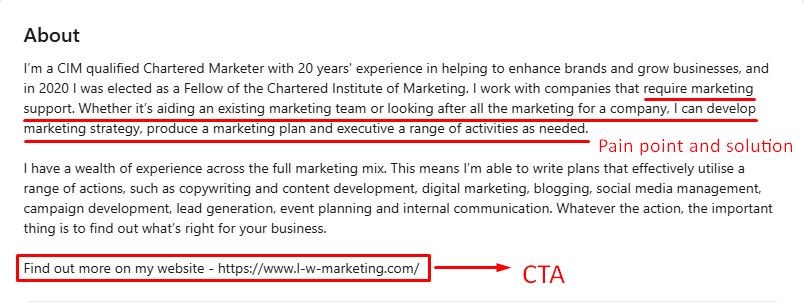
4. Showcase Your Skills & Build Trust with Recommendations
Highlight your expertise by listing relevant skills.
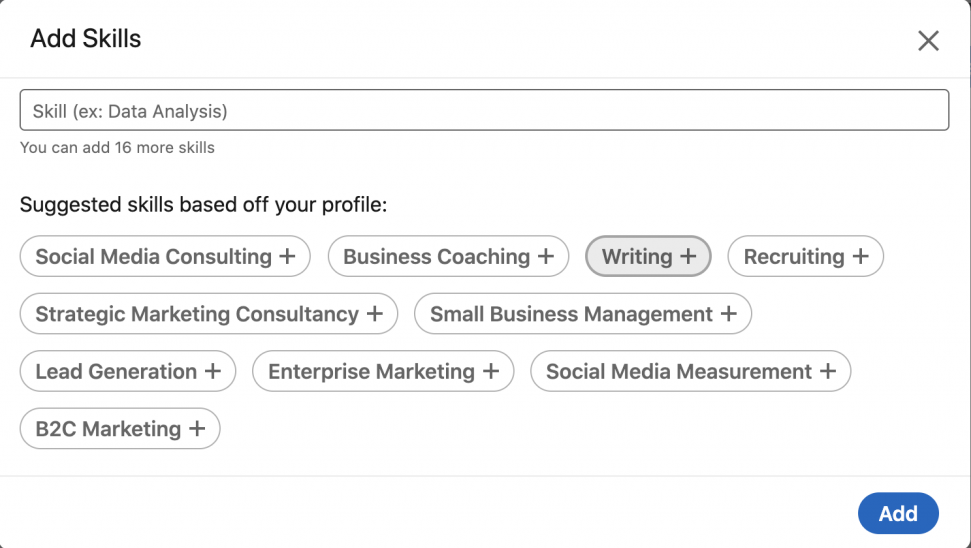
Also, ask satisfied clients or colleagues for recommendations because they are very powerful social proof of your capabilities.
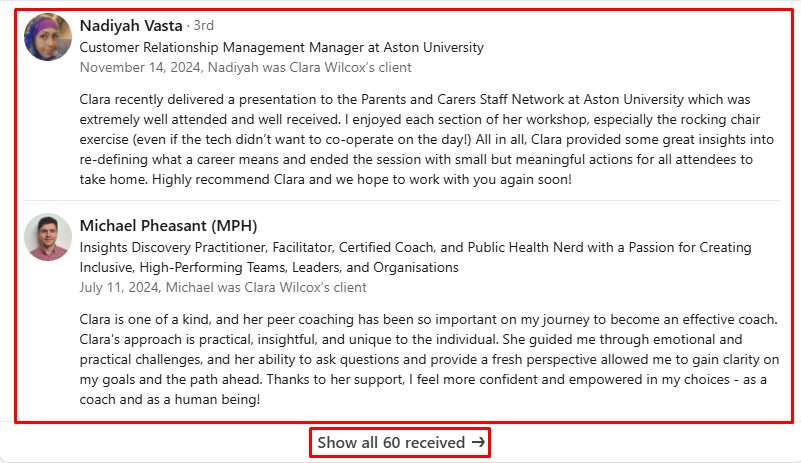
5. Make It Easy to Connect
Don’t hide your contact information.
Share your contact details openly so that potential leads can contact you easily.
Tip: Add an email ID or website to the LinkedIn banner.

2. Build a Targeted Network on Linkedin
Your network = Your net worth💸
To generate leads on LinkedIn, you need the right connections and relationships.
Follow these steps:
1. Connect with the Right People, Not Just Anyone
Don’t waste time on scrolling.
Use LinkedIn’s search filters to target leads based on the industry, job title, location, and company size.
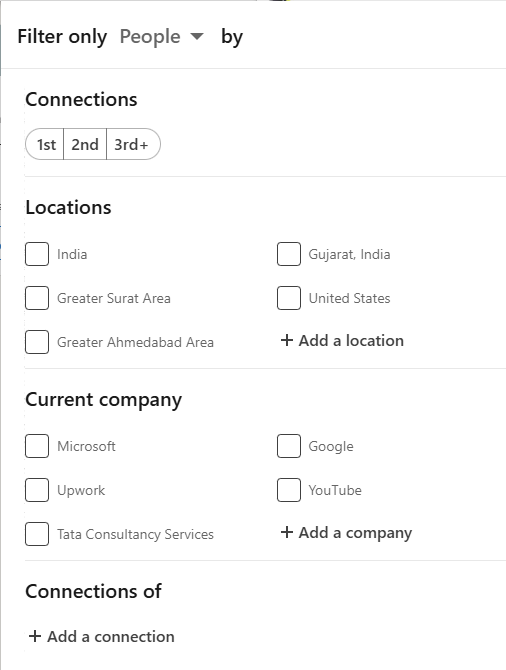
But manually searching and adding leads one by one is quite time-consuming and exhausting also.
Wait, I heard that there is a tool that can save you from this situation — ScrapeLead’s Linkedin Scraper.
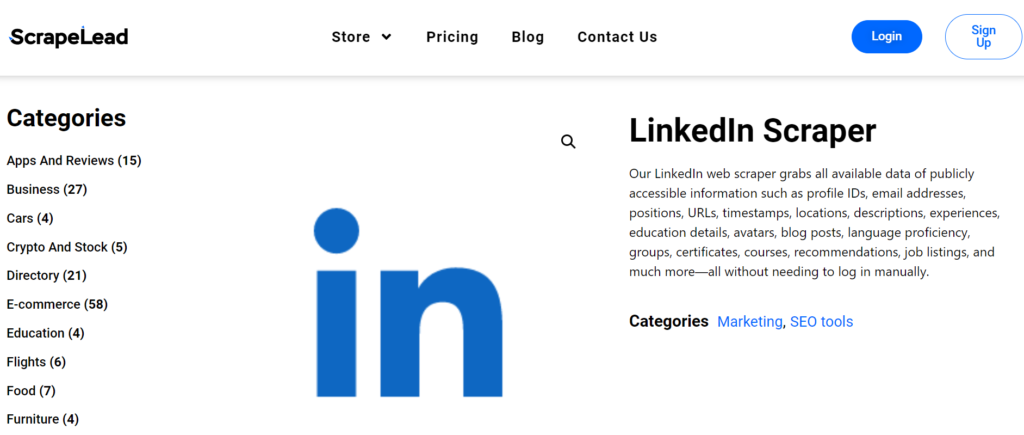
With this tool, you can simply extract LinkedIn profiles in bulk based on your ideal customer criteria with just a few clicks. (ONE thing I forgot to mention is – without coding.)
Don’t you believe in me?
No more manual searching—just an organized list of potential leads ready for outreach.
2. Send Connection Requests That Feel Genuine
Only “Let’s connect” won’t do! Create a message that adds value.
For example:
“Hi [Name], I love your work in [Industry] and would love to connect and exchange insights!”
3. Stay Active So People Remember You
If one of your network posts on LinkedIn, like their post and add one comment according to their post.
Engaging consistently keeps you visible and top of mind when they need your services.
For example:
- If the post is related to hiring, comment ‘#cfbr’ or ‘Great Opportunity.’
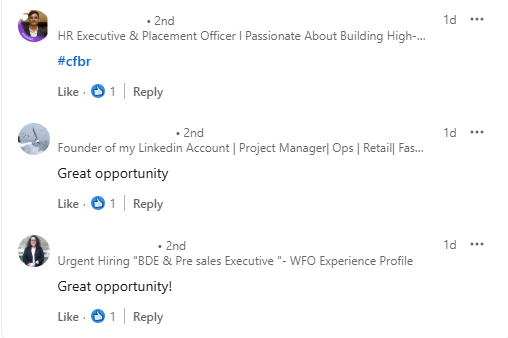
- If the post is about starting a new position, comment ‘Congratulations’ or offer well wishes.
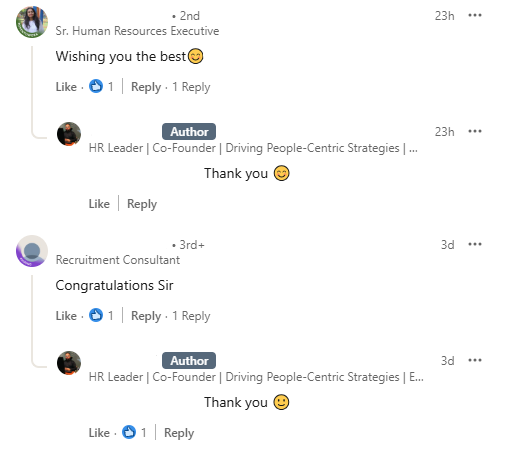
3. Create and Share Valuable Content on LinkedIn
Content is king even though on LinkedIn also.
This is one of the best ways to get leads from LinkedIn.
But how:
1. Share Content That Educates, Not Just Sells
Post content that educates your audience.
Share some important tips, case studies, industry insights, and how-to guides.
For example: “How to generate b2b leads on LinkedIn”
If possible then also share a funny incident that happened to you or a meme related to your job or business to entertain your audience.
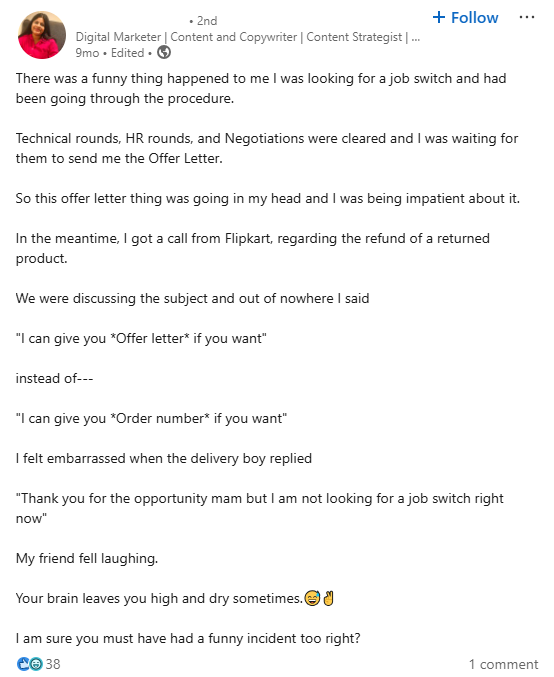
2. Mix It Up: Posts, Videos, Polls & More
Don’t post just text. Use a variety of content to keep your audience engaged.
✅ Posts & Articles – Share insights, case studies, and industry-specific strategies.
✅ Videos & Graphics – Use eye-catching visuals to increase engagement.
✅ Polls & Questions – Invite opinions and discussions.
3. Stay Consistent
Posting regularly keeps you in front of your audience.
Even if the leads don’t need your services today, they will remember you when they do!
By constantly sharing high-value content, you will naturally attract prospects, increase engagement, and grow your LinkedIn network with the right people.
4. Leverage LinkedIn Sales Navigator for Lead Generation
If you are serious about lead generation then Linked Sales Navigator is your game-changer.
Here is how you could best utilize it:
1. Advanced Filters
Boolean searches and advanced filters are used to find high-specific leads that match your ideal customer profile.
2. Saved Leads
Track promising prospects by saving them to your list and following their activity so you don’t miss anything.
3. Deep Insights
It will give you in-depth analytics on decision-makers and companies to understand their needs and reach out more effectively.
Unlock better lead targeting, stay organized, and gain valuable insights with LinkedIn Sales Navigator – the supercharger of lead generation on LinkedIn.
5. Use Lead Gen Ads LinkedIn
LinkedIn lead gen ads is a brilliant way to get high-quality leads directly from the platform.
Here’s how to make it work for you:
1. Target the right demographics
Segment the audience by using industry, job title, and location to capture the ideal lead.
2. Offer free resources
To get contact details, give the audience something that is valuable – an eBook, webinar, or whitepaper, for example.
3. Compelling Ad Copy
Create ad copy that will be easy to read and highlight the benefits of your offer, solving the pain points of your audience.
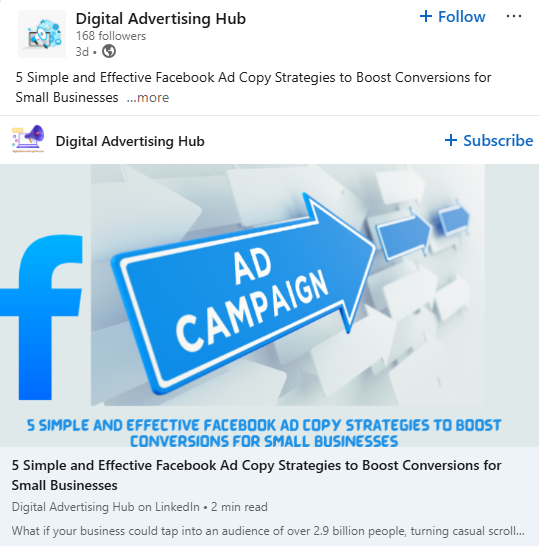
4. Lead Gen Forms
Take advantage of LinkedIn’s Lead Gen Forms, which are pre-filled with the user’s information, making it easier for prospects to submit their details.
6. Engage in LinkedIn Groups
1. Join the Right LinkedIn Groups
Look for groups specific to your industry or niche. Engage by joining the discussion, sharing your helpful tips and advice.
Doing so will garner trust and convey that you truly know your stuff.
2. Start Your Own Group (If It Makes Sense)
If you are unable to find a group, then why not create one?
That way, you could get people who share the same feelings about similar things.
Placed in that position, you will surely become one of the top experts in that specific field.
3. Be active in group discussions
Whether in someone else’s group or your own, participate in the discussion!
Answer questions, provide helpful tips, and connect with others.
The more helpful you are, the more people will consider you to be a trusted individual.
4. Connect with potential leads
As you chat in groups, you will find active members who might be good fits for your business.
Make a connection request, but DON’T do it in a pushy manner; instead, build a relationship to make the other person comfortable.
Nobody likes a hard sell. Instead, share value—like helpful advice or insights—and let people get to know you.
When they see you’re an expert who cares, they’ll naturally want to learn more about what you do.
7. Host Webinars and LinkedIn Events
Hosting webinars and events is one of the best methods to connect to your audience as well as get leads.
Let’s see how to make most of them:
1. Choose a topic your audience cares about
Host free webinars or events based on topics that solve a problem or interest your target audience.
For example, if you’re in marketing, you can have a webinar that says, “5 Strategies to Boost Your Social Media Engagement.”
2. Promote Your Event
Use LinkedIn posts, ads, and if possible, direct messages to remind people of the event.
Do not forget to add a link to the registration form so people can sign up.
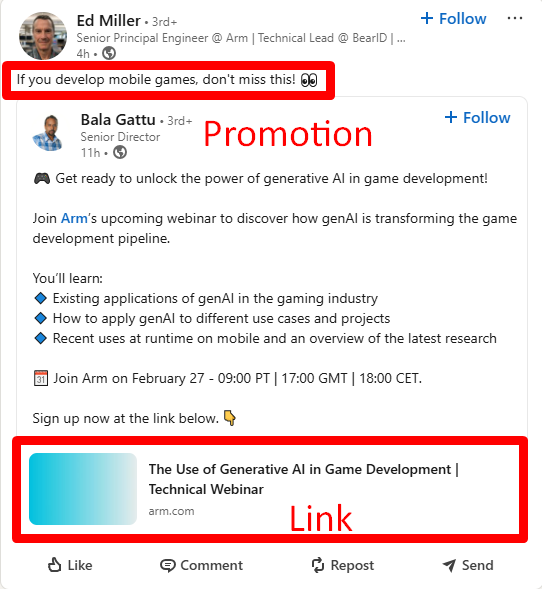
3. Engage During the Event
Engage with your audience through live Q&A sessions, polls, or chats during the live event.
In short, make it interactive!
4. Follow up After the Event
Do not let the conversation end with the audience when the event has ended.
Follow up with thanks messages and if applicable share the recording of the event.
Pro tip: Give them more of something- a FREE resource or one-on-one consultation.
8. Use LinkedIn Analytics to Improve Your Strategy
Pay attention to how you are doing so you can iterate on what works and course-correct what’s not.
1. Profile Views
You can see who is visiting your profile–they might be potential leads!
Shoot them a nice message.
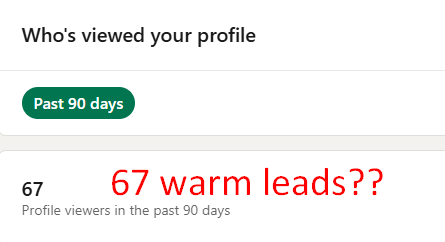
2. Content Performance
See which posts generate the most likes, comments, or shares.
Double down on what resonates with your audience.

3. Campaign Metrics
If you’re running LinkedIn ads, use Ads Manager to track your results and make your campaigns even better.
9. Automate and Scale Your Efforts
Save your time by automating repetitive work so you can spend more on creating real relationships and closing the deal.
1. Integrate with a CRM:
Integrate LinkedIn with Salesforce, HubSpot, or Zoho and keep all the leads organized; track interactions; and set reminders for follow-up.
This is how you do not lose any potential clients.
2. Automation Tools:
Use Dux-Soup, Meet Alfred, or Octopus CRM to send personalized connection requests and follow-up messages in bulk.
Just be sure not to sound like a robot—always add a human touch!
3. Email Sequences:
Combining LinkedIn outreach with email automation can be done by using tools such as Mailchimp, Lemlist, or Woodpecker.
This multi-channel approach keeps the prospect on their radar and significantly increases response rates.
But how to build an email list?
What if I tell you that you can build your own email list totally free…
Yes, this is possible.
By using ScrapeLead’s Email Extractor, you can extract all email addresses from any website.
10. Keep Up with What's Hot on LinkedIn
LinkedIn is very dynamic, and keeping ahead of trends will separate you from your competition.
1. Video content:
Shorter, interesting videos (like Stories or Reels) grab one’s attention much quicker than text does.
Quick tips, behind-the-scenes, and successful stories all have a lot to do with building a personal connection with your audience.
2. AI Insights:
LinkedIn AI tools analyze user behavior and suggest their potential interest in topics, trending posts, and a preference that could be developed.
Use these insights to create high-impact posts to draw engagement.
3. New Features:
Try out the latest updates on LinkedIn, such as audio events, collaborative articles, and newsletters.
Being an early adopter of new features can give you an edge and increase your visibility.
Keeping up with LinkedIn trends ensures you stay relevant and maximize your engagement.
11. Measure and Improve Your Results
Success on LinkedIn is not just about activity; it’s about getting real results.
Monitor your performance to see what’s working and improve.
1. Track Conversions:
Using LinkedIn Campaign Manager or Google Analytics, see which posts, messages, or ads are bringing in the most leads.
2. A/B Testing:
Test different types of messages, CTAs, and content to see which type garners the best response.
Little things make a huge difference most of the time.
Targeting:
If you don’t get enough engagement then adjust the audience filter on job title, industry, and company size so that the right kind of people are viewing.
Request Feedback:
Through polls or even direct messages, find out what your audience would like more of.
They might just have an idea about improving your strategy.
Conclusion
LinkedIn is a powerful lead-generation tool if you use it the right way. Optimize your profile, build a strong network, share valuable content, and leverage tools like Sales Navigator and Lead Gen Ads to attract leads effortlessly.
To save time, ScrapeLead’s LinkedIn Scraper helps in extracting profiles in bulk, whereas ScrapeLead’s Email Extractor pulls in email addresses to make outreach simpler. So no more manual searching, just ready-to-use leads give more time to be spent on the relationship-building stage and closing of deals.
Stick to consistency with smart tools. Keep experimenting with strategies, and watch your LinkedIn lead generation soar!
FAQ
Optimize profile, network, post valuable content, and use LinkedIn lead gen ads and Sales Navigator.
Sales Navigator, Lead Gen Ads, automation tools, and Scrapelead’s scrapers streamline outreach.
Use search filters, connect to decision-makers, groups, and LinkedIn lead generation strategy.
Indeed, lead generation companies from LinkedIn provide targeted outreach and automation for better results.
ScrapeLead’s LinkedIn Scraper is used to extract profiles in bulk, while its Email Extractor is to find emails for outreach.
Related Blog

11 Real-World Use Cases of Web Scraping in 2025
Explore 11 powerful examples of web scraping and see how to use data to gain insights, leads, and a market edge in 2025.

Which Review Scraper Is Best for Your E-commerce Business?
Want a simple way to start scraping reviews? Learn how to grab real customer feedback and make smarter product decisions fast.

How to Scrape Social Media Without Coding (2025 Guide)
Discover how to collect social media data effortlessly with no-code tools in this 2025 guide.
